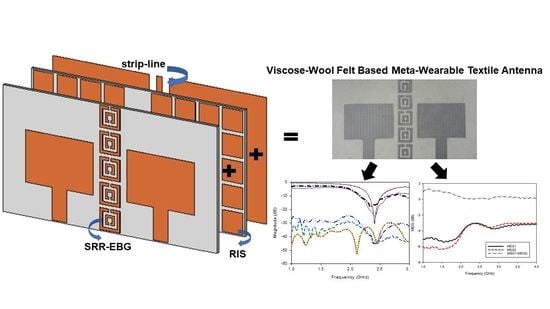Combined RIS and EBG Surfaces Inspired Meta-Wearable Textile MIMO Antenna Using Viscose-Wool Felt
Abstract
:1. Introduction
2. Flexible Polymer-Based Meta-Wearable Antenna Design
2.1. Reactive Impedance Surface Design with Rectangular Patch Antenna
2.2. Electromagnetic Band-Gap Design
2.3. MIMO Antenna Design Geometry and Configurations
3. Results and Discussion
3.1. Advantages of RIS for Patch Antenna
3.2. Performance Enhancement by Stripline Backed SRR-EBG
3.3. MIMO Properties of the Proposed Antenna
4. Conclusions
Author Contributions
Funding
Institutional Review Board Statement
Informed Consent Statement
Data Availability Statement
Conflicts of Interest
References
- Joshi, R.; Hussin, E.F.N.M.; Soh, P.J.; Jamlos, M.F.; Lago, H.; Al-Hadi, A.A.; Podilchak, S.K. Dual-Band, Dual-Sense Textile Antenna with AMC Backing for Localization Using GPS and WBAN/WLAN. IEEE Access 2020, 8, 89468–89478. [Google Scholar] [CrossRef]
- Shrestha, S.; Agarwal, M.; Ghane, P.; Varahramyan, K. Flexible Microstrip Antenna for Skin Contact Application. Int. J. Antennas Propag. 2012, 2012, 745426. [Google Scholar] [CrossRef]
- Kuang, Y.; Yao, L.; Yu, S.-H.; Tan, S.; Fan, X.-J.; Qiu, Y.-P. Design and Electromagnetic Properties of a Conformal Ultra Wideband Antenna Integrated in Three-Dimensional Woven Fabrics. Polymers 2018, 10, 861. [Google Scholar] [CrossRef] [Green Version]
- Ali Khan, M.U.; Raad, R.; Tubbal, F.; Theoharis, P.I.; Liu, S.; Foroughi, J. Bending Analysis of Polymer-Based Flexible Antennas for Wearable, General IoT Applications: A Review. Polymers 2021, 13, 357. [Google Scholar] [CrossRef]
- Almohammed, B.; Ismail, A.; Sali, A. Electro-Textile Wearable Antennas in Wireless Body Area Networks: Materials, Antenna Design, Manufacturing Techniques, and Human Body Consideration—A Review. Text. Res. J. 2021, 91, 646–663. [Google Scholar] [CrossRef]
- Huang, X.; Leng, T.; Zhang, X.; Chen, J.C.; Chang, K.H.; Geim, A.K.; Novoselov, K.S.; Hu, Z. Binder-Free Highly Conductive Graphene Laminate for Low Cost Printed Radio Frequency Applications. Appl. Phys. Lett. 2015, 106, 203105. [Google Scholar] [CrossRef]
- Sayem, A.S.M.; Simorangkir, R.B.V.B.; Esselle, K.P.; Hashmi, R.M. Development of Robust Transparent Conformal Antennas Based on Conductive Mesh-Polymer Composite for Unobtrusive Wearable Applications. IEEE Trans. Antennas Propag. 2019, 67, 7216–7224. [Google Scholar] [CrossRef]
- Corchia, L.; Monti, G.; Tarricone, L. Durability of Wearable Antennas Based on Nonwoven Conductive Fabrics: Experimental Study on Resistance to Washing and Ironing. Int. J. Antennas Propag. 2018, 2018, 1–8. [Google Scholar] [CrossRef]
- Hossain, K.; Sabapathy, T.; Jusoh, M.; Abdelghany, M.A.; Soh, P.J.; Osman, M.N.; Yasin, M.N.M.; Rahim, H.A.; Al-Bawri, S.S. A Negative Index Nonagonal CSRR Metamaterial-Based Compact Flexible Planar Monopole Antenna for Ultrawideband Applications Using Viscose-Wool Felt. Polymers 2021, 13, 2819. [Google Scholar] [CrossRef]
- Farooq, S.; Tahir, A.A.; Krewer, U.; Ul Haq Ali Shah, A.; Bilal, S. Efficient Photocatalysis through Conductive Polymer Coated FTO Counter Electrode in Platinum Free Dye Sensitized Solar Cells. Electrochim. Acta 2019, 320, 134544. [Google Scholar] [CrossRef]
- Rahman, S.u.; Röse, P.; Surati, M.; Shah, A.u.H.A.; Krewer, U.; Bilal, S. 3D Polyaniline Nanofibers Anchored on Carbon Paper for High-Performance and Light-Weight Supercapacitors. Polymers 2020, 12, 2705. [Google Scholar] [CrossRef]
- Ur Rahman, S.; Röse, P.; ul Haq Ali Shah, A.; Krewer, U.; Bilal, S. An Amazingly Simple, Fast and Green Synthesis Route to Polyaniline Nanofibers for Efficient Energy Storage. Polymers 2020, 12, 2212. [Google Scholar] [CrossRef]
- Ur Rahman, S.; Röse, P.; ul Haq Ali Shah, A.; Krewer, U.; Bilal, S.; Farooq, S. Exploring the Functional Properties of Sodium Phytate Doped Polyaniline Nanofibers Modified FTO Electrodes for High-Performance Binder Free Symmetric Supercapacitors. Polymers 2021, 13, 2329. [Google Scholar] [CrossRef]
- Rahman, S.U.; Bilal, S.; ul Haq Ali Shah, A. Synthesis and Characterization of Polyaniline-Chitosan Patches with Enhanced Stability in Physiological Conditions. Polymers 2020, 12, 2870. [Google Scholar] [CrossRef]
- Tanveer ul Haq, Z.; Anwar ul Haq Ali, S. Understanding the Adsorption of 1 NLB Antibody on Polyaniline Nanotubes as a Function of Zeta Potential and Surface Charge Density for Detection of Hepatitis C Core Antigen: A Label-Free Impedimetric Immunosensor. Colloids Surfaces A Physicochem. Eng. Asp. 2021, 626, 127076. [Google Scholar] [CrossRef]
- Bibi, S.; Ullah, H.; Ahmad, S.M.; Ali Shah, A.-H.; Bilal, S.; Tahir, A.A.; Ayub, K. Molecular and Electronic Structure Elucidation of Polypyrrole Gas Sensors. J. Phys. Chem. C 2015, 119, 15994–16003. [Google Scholar] [CrossRef]
- Alqadami, A.S.M.; Bialkowski, K.S.; Mobashsher, A.T.; Abbosh, A.M. Wearable Electromagnetic Head Imaging System Using Flexible Wideband Antenna Array Based on Polymer Technology for Brain Stroke Diagnosis. IEEE Trans. Biomed. Circuits Syst. 2019, 13, 124–134. [Google Scholar] [CrossRef]
- Hossain, K.; Sabapathy, T.; Jusoh, M.; Lee, S.-H.; Rahman, K.S.A.; Kamarudin, M.R. Negative Index Metamaterial-Based Frequency-Reconfigurable Textile CPW Antenna for Microwave Imaging of Breast Cancer. Sensors 2022, 22, 1626. [Google Scholar] [CrossRef]
- Khajeh-Khalili, F. A Broadband All-Textile Wearable MIMO Antenna for Wireless Telecommunication/Medical Applications. J. Text. Inst. 2020, 112, 2013–2020. [Google Scholar] [CrossRef]
- Zhu, L.; Hwang, H.S.; Ren, E.; Yang, G. High Performance MIMO Antenna for 5G Wearable Devices. In Proceedings of the 2017 IEEE International Symposium on Antennas and Propagation & USNC/URSI National Radio Science Meeting, San Diago, CA, USA, 9–14 July 2017; pp. 1869–1870. [Google Scholar]
- Li, Y.; Shen, H.; Zou, H.; Wang, H.; Yang, G. A Compact UWB MIMO Antenna for 4.5G/5G Wearable Device Applications. In Proceedings of the 2017 IEEE 6th Asia-Pacific Conference on Antennas and Propagation, APCAP 2017—Proceeding, Xi’an, China, 25 July 2018; Institute of Electrical and Electronics Engineers Inc.: New York, NY, USA, 2018; pp. 1–3. [Google Scholar]
- Abbasi, Q.H.; Ur-Rehman, M.; Qaraqe, K.; Alomainy, A. Advances in Body-Centric Wireless Communication: Applications and State-of-the-Art; Ur-Rehman, Q., Alomainy, A., Eds.; Institution of Engineering and Technology: Stevenage, UK, 2016; ISBN 9781849199896. [Google Scholar]
- Ramamohan, B.; Usha, S.; Ananth, P.; Lalitha, V.S.; Jaswanth, S. Design of Dumbbell-Shaped MIMO Antenna for Wearable Applications; Springer: Singapore, 2021; pp. 293–303. ISBN 9789811584381. [Google Scholar]
- Gupta, A.; Kansal, A.; Chawla, P. Design of a Wearable MIMO Antenna Deployed with an Inverted U-Shaped Ground Stub for Diversity Performance Enhancement. Int. J. Microw. Wirel. Technol. 2021, 13, 76–86. [Google Scholar] [CrossRef]
- Sharawi, M.S. Current Misuses and Future Prospects for Printed Multiple-Input, Multiple-Output Antenna Systems [Wireless Corner]. IEEE Antennas Propag. Mag. 2017, 59, 162–170. [Google Scholar] [CrossRef]
- Lago, H.; Soh, P.J.; Jamlos, M.F.; Shohaimi, N.; Yan, S.; Vandenbosch, G.A.E. Textile Antenna Integrated with Compact AMC and Parasitic Elements for WLAN/WBAN Applications. Appl. Phys. A Mater. Sci. Process. 2016, 122, 1059. [Google Scholar] [CrossRef]
- Ashyap, A.Y.I.; Elamin, N.I.M.; Dahlan, S.H.; Abidin, Z.Z.; See, C.H.; Majid, H.A.; AL-Fadhali, N.; Mukred, J.A.A.; Saleh, G.; Esmail, B.A.F. Via-Less Electromagnetic Band-Gap-Enabled Antenna Based on Textile Material for Wearable Applications. PLoS ONE 2021, 16, e0246057. [Google Scholar] [CrossRef]
- Roy, S.; Chakraborty, U. Mutual Coupling Reduction in a Multi-Band MIMO Antenna Using Meta-Inspired Decoupling Network. Wirel. Pers. Commun. 2020, 114, 3231–3246. [Google Scholar] [CrossRef]
- Chatterjee, J.; Mohan, A.; Dixit, V. Broadband Circularly Polarized H-Shaped Patch Antenna Using Reactive Impedance Surface. IEEE Antennas Wirel. Propag. Lett. 2018, 17, 625–628. [Google Scholar] [CrossRef]
- Mosallaei, H.; Sarabandi, K. Antenna Miniaturization and Bandwidth Enhancement Using a Reactive Impedance Substrate. IEEE Trans. Antennas Propag. 2004, 52, 2403–2414. [Google Scholar] [CrossRef] [Green Version]
- Ashyap, A.Y.I.; Dahlan, S.H.B.; Zainal Abidin, Z.; Abbasi, M.I.; Kamarudin, M.R.; Majid, H.A.; Dahri, M.H.; Jamaluddin, M.H.; Alomainy, A. An Overview of Electromagnetic Band-Gap Integrated Wearable Antennas. IEEE Access 2020, 8, 7641–7658. [Google Scholar] [CrossRef]
- Sabapathy, T.; Soh, P.J.; Jusoh, M. A Three-Year Improvement Assessment of Project-Based Learning for an Antennas and Propagation Course [Education Corner]. IEEE Antennas Propag. Mag. 2020, 62, 76–84. [Google Scholar] [CrossRef]
- Biswas, A.K.; Chakraborty, U. Reduced Mutual Coupling of Compact MIMO Antenna Designed for WLAN and WiMAX Applications. Int. J. RF Microw. Comput. Eng. 2019, 29, e21629. [Google Scholar] [CrossRef]
- Abdullah, M.; Kiani, S.H.; Iqbal, A. Eight Element Multiple-Input Multiple-Output (MIMO) Antenna for 5G Mobile Applications. IEEE Access 2019, 7, 134488–134495. [Google Scholar] [CrossRef]
- Li, Y.; Sim, C.-Y.-D.; Luo, Y.; Yang, G. Multiband 10-Antenna Array for Sub-6 GHz MIMO Applications in 5-G Smartphones. IEEE Access 2018, 6, 28041–28053. [Google Scholar] [CrossRef]
- Serghiou, D.; Khalily, M.; Singh, V.; Araghi, A.; Tafazolli, R. Sub-6 GHz Dual-Band 8 × 8 MIMO Antenna for 5G Smartphones. IEEE Antennas Wirel. Propag. Lett. 2020, 19, 1546–1550. [Google Scholar] [CrossRef]
- Ding, Y.; Du, Z.; Gong, K.; Feng, Z. A Novel Dual-Band Printed Diversity Antenna for Mobile Terminals. IEEE Trans. Antennas Propag. 2007, 55, 2088–2096. [Google Scholar] [CrossRef] [Green Version]
- Yan, S.; Soh, P.J.; Vandenbosch, G.A.E. Dual-Band Textile MIMO Antenna Based on Substrate-Integrated Waveguide (SIW) Technology. IEEE Trans. Antennas Propag. 2015, 63, 4640–4647. [Google Scholar] [CrossRef]
- Biswas, A.K.; Chakraborty, U. Compact wearable MIMO antenna with improved port isolation for ultra-wideband applications. IET Microw. Antennas Propag. 2019, 13, 498–504. [Google Scholar] [CrossRef]
- Biswas, A.K.; Chakraborty, U. Investigation on decoupling of wide band wearable multiple-input multiple-output antenna elements using microstrip neutralization line. Int. J. RF Microw. Comput. Eng. 2019, 29, e21723. [Google Scholar] [CrossRef]
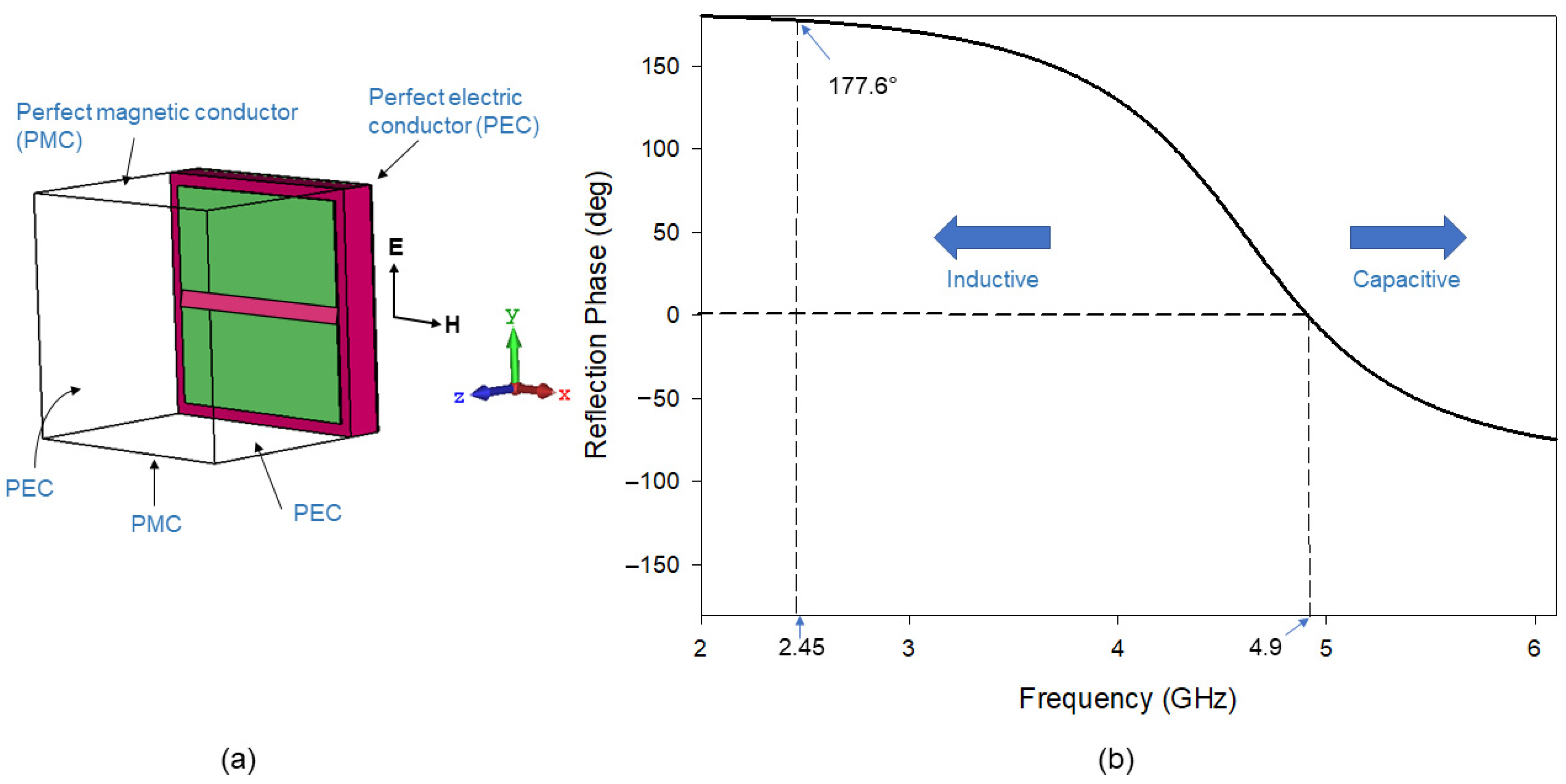
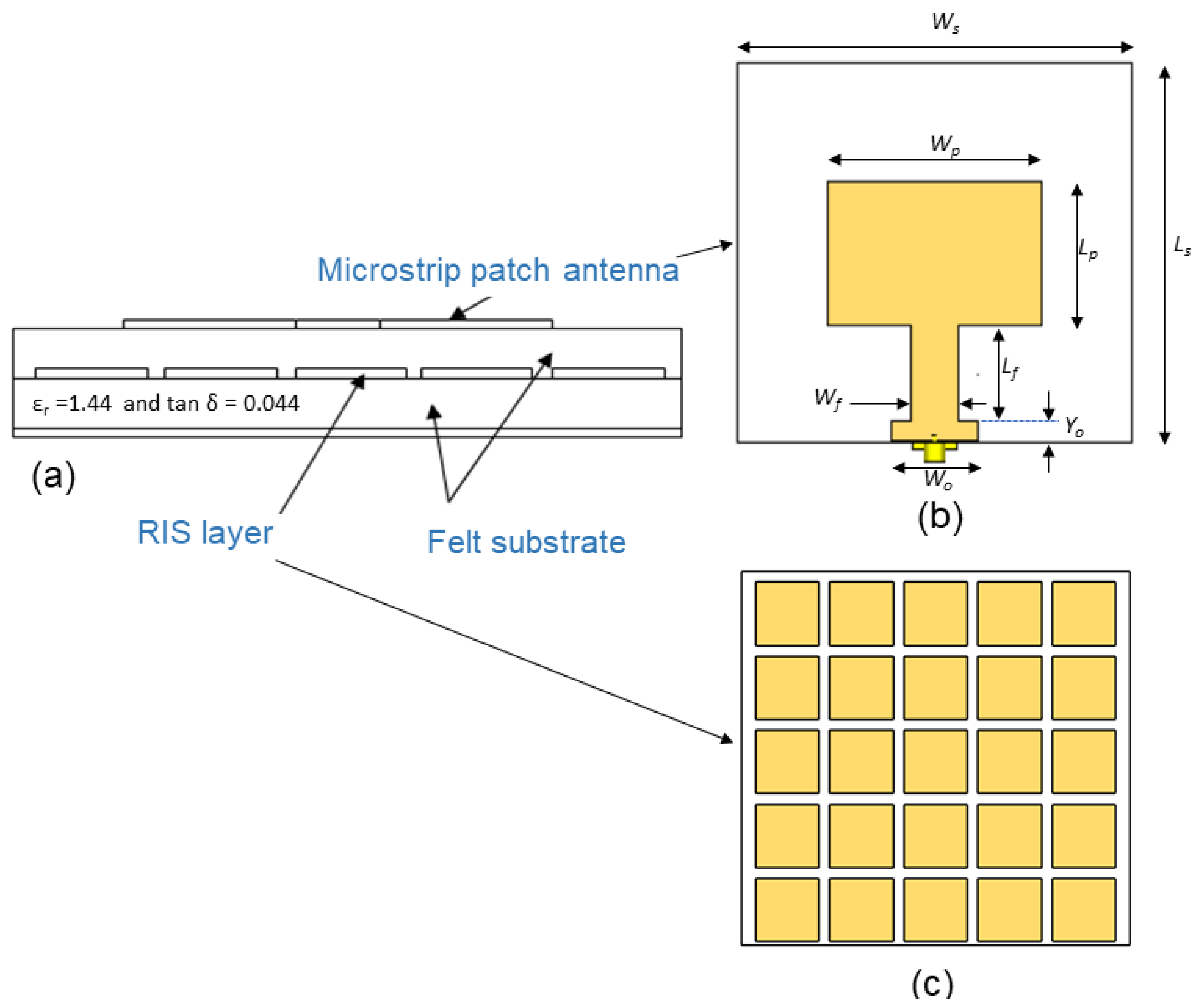
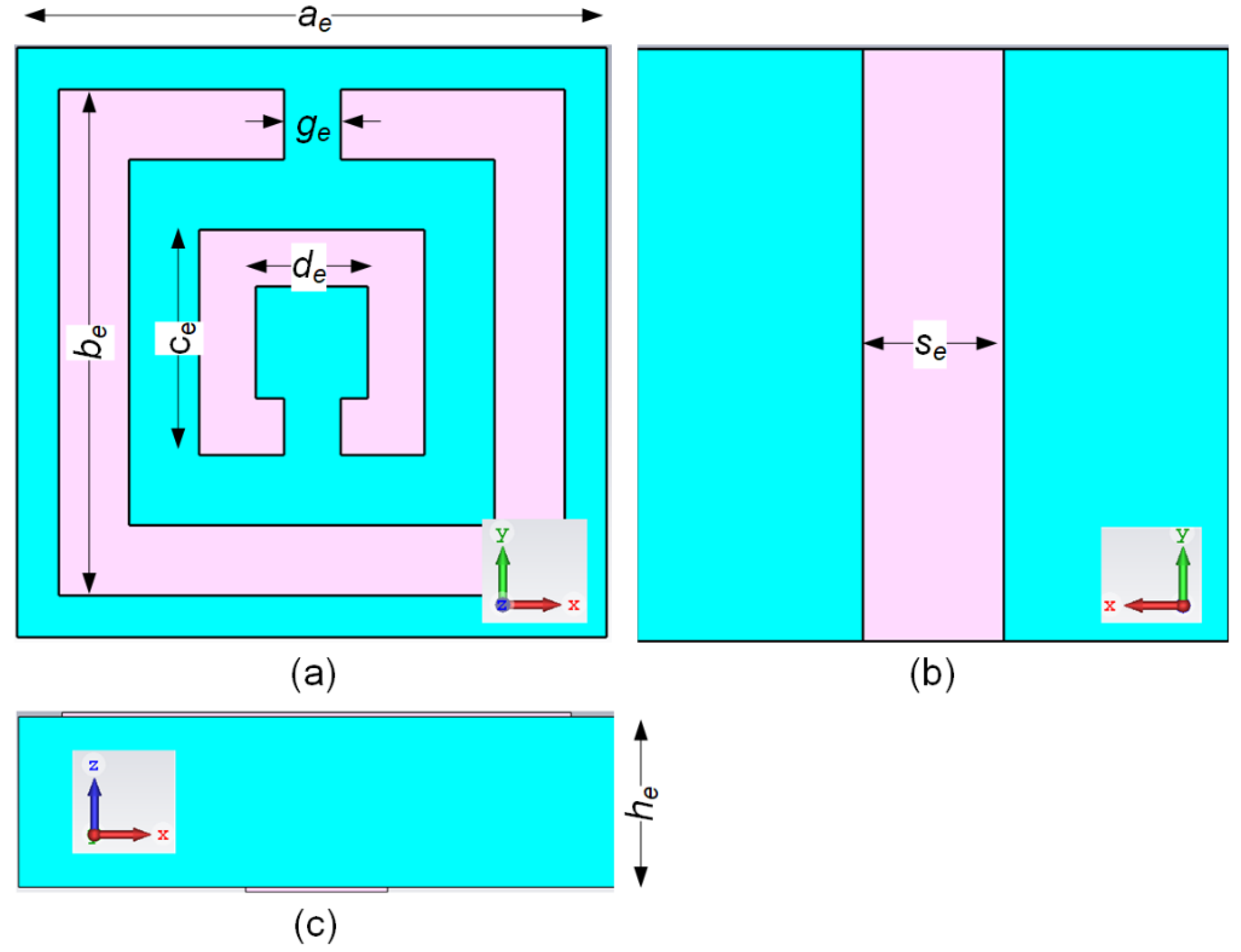

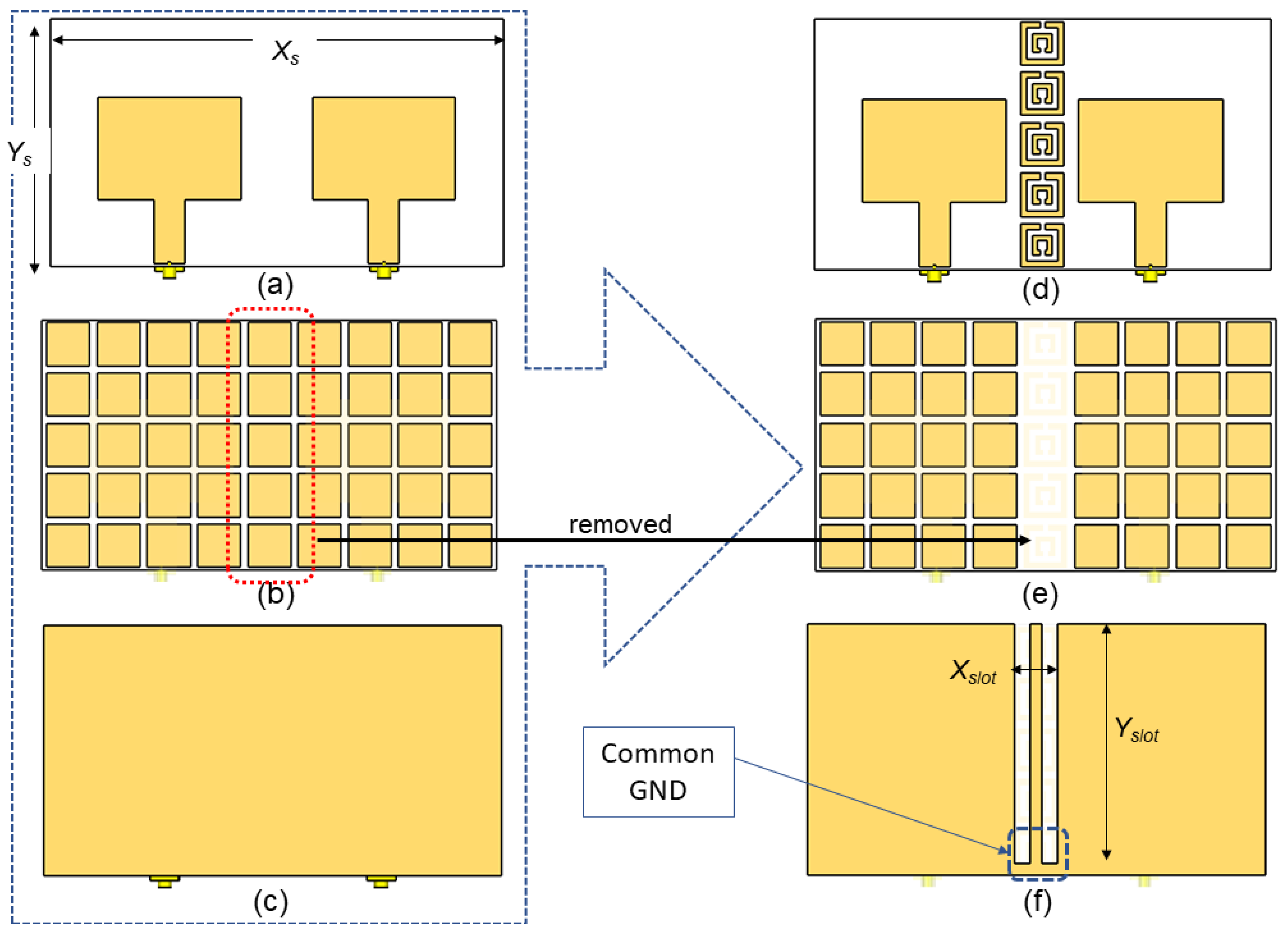

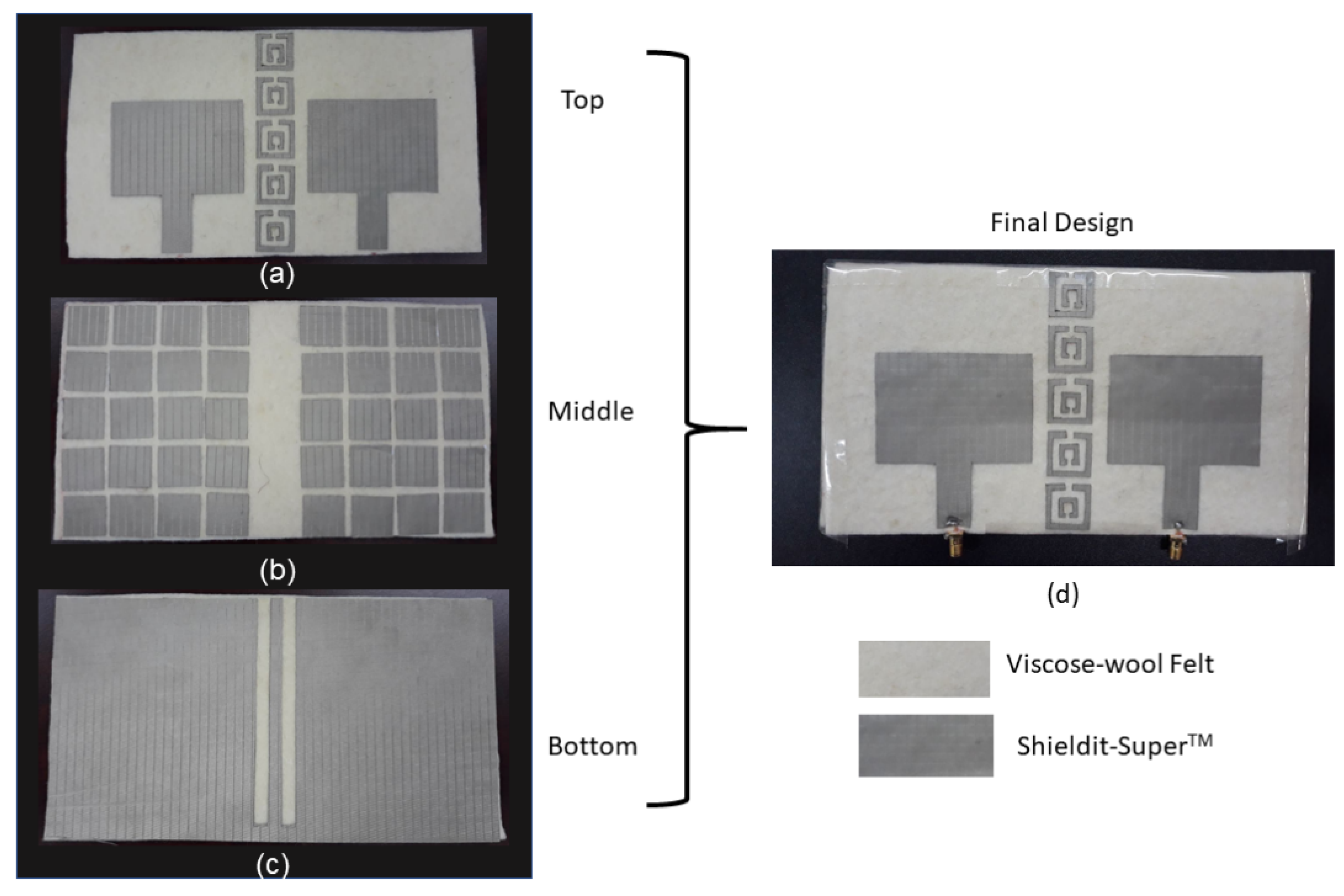
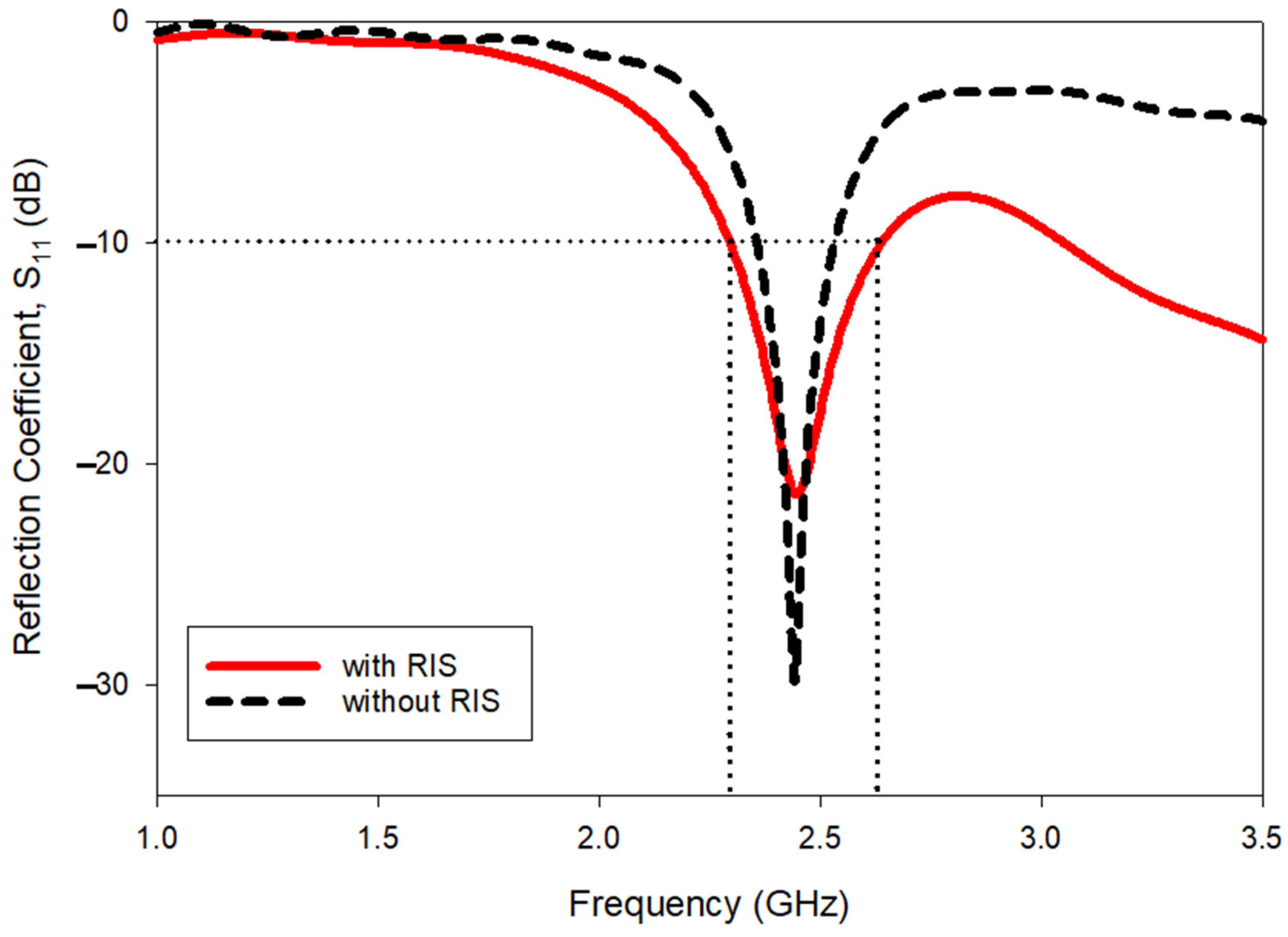
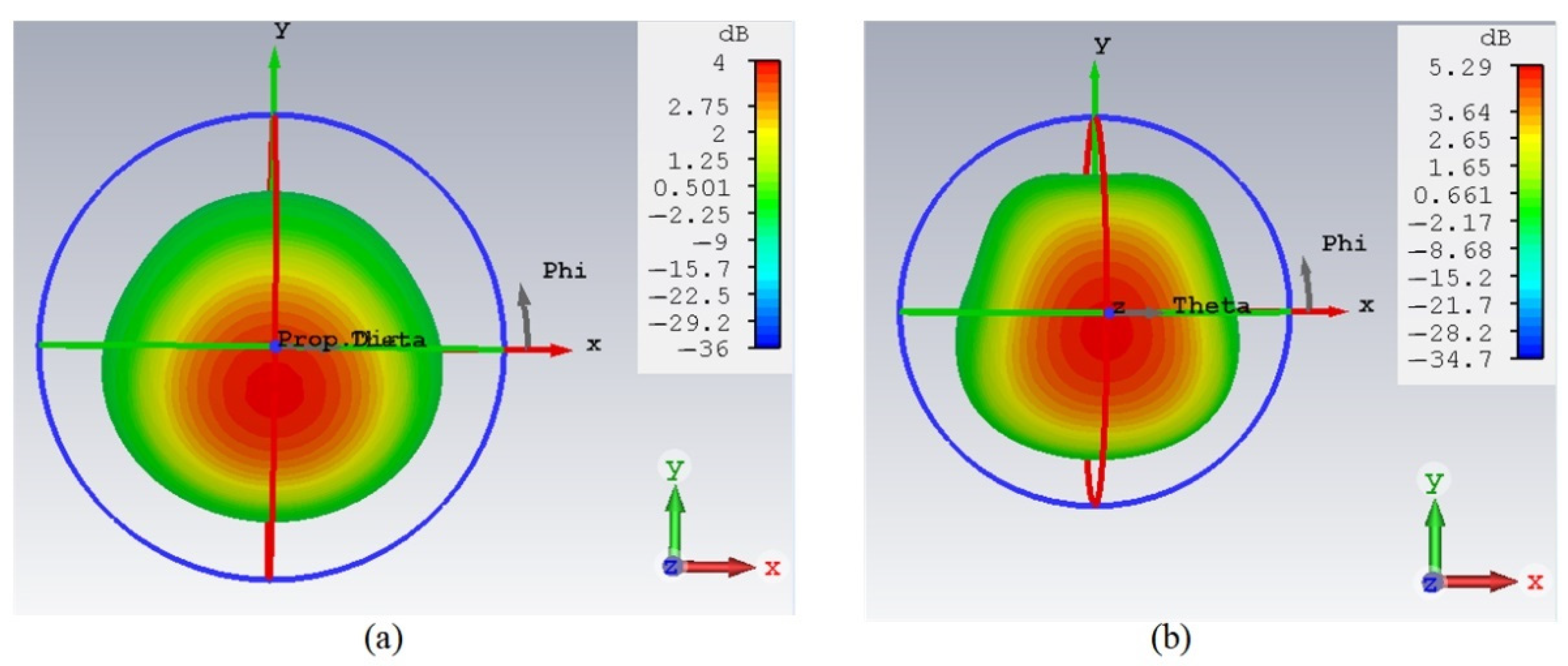

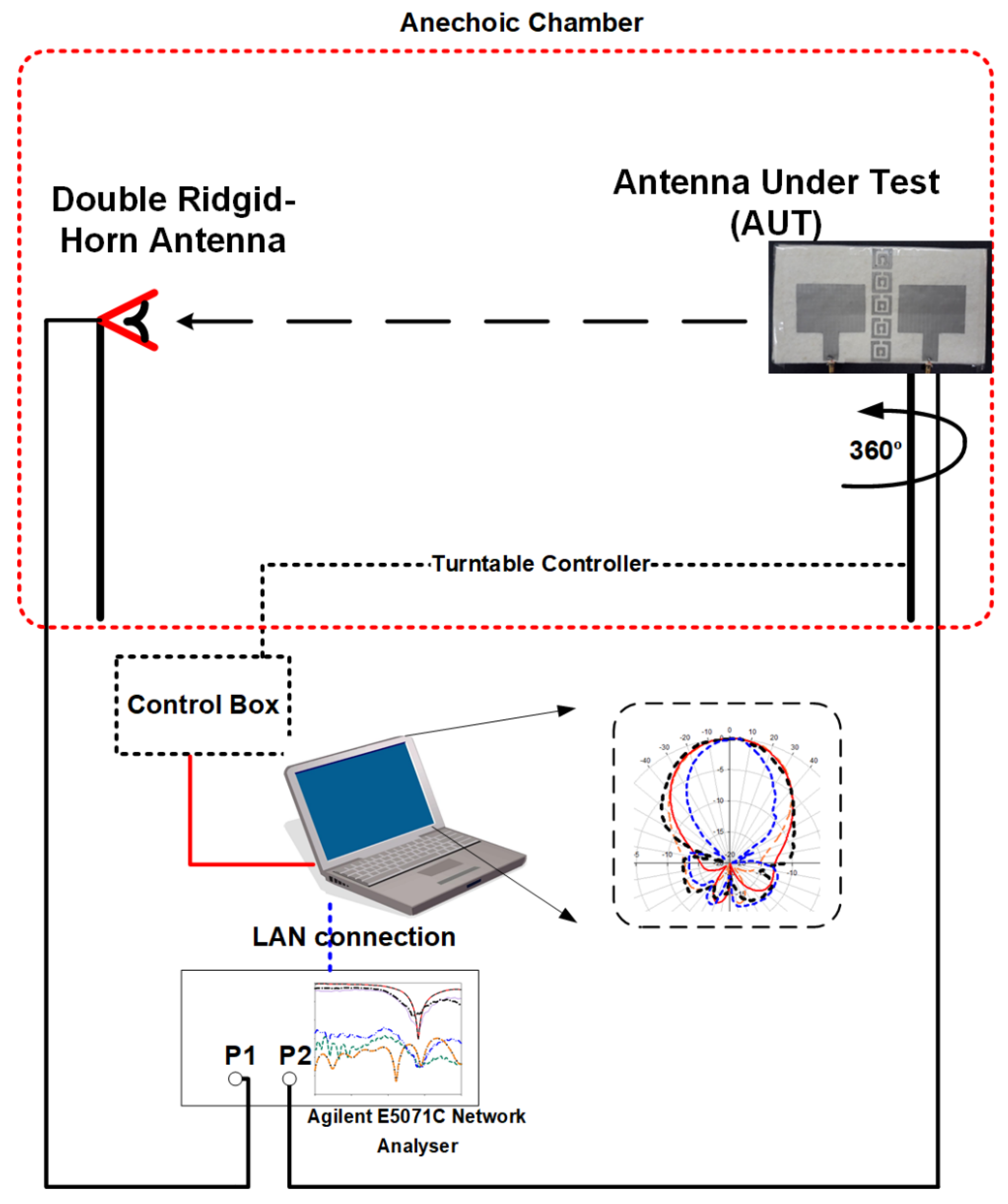

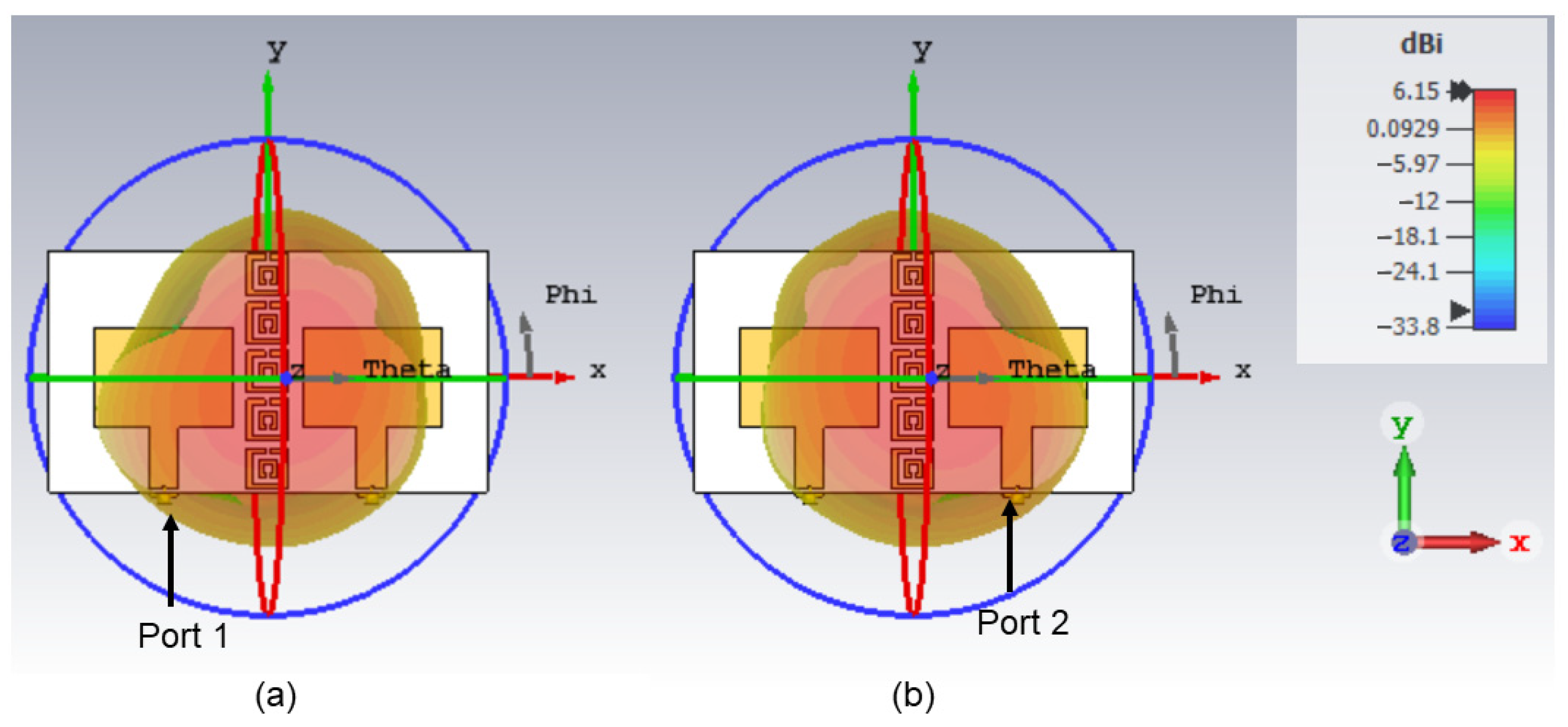

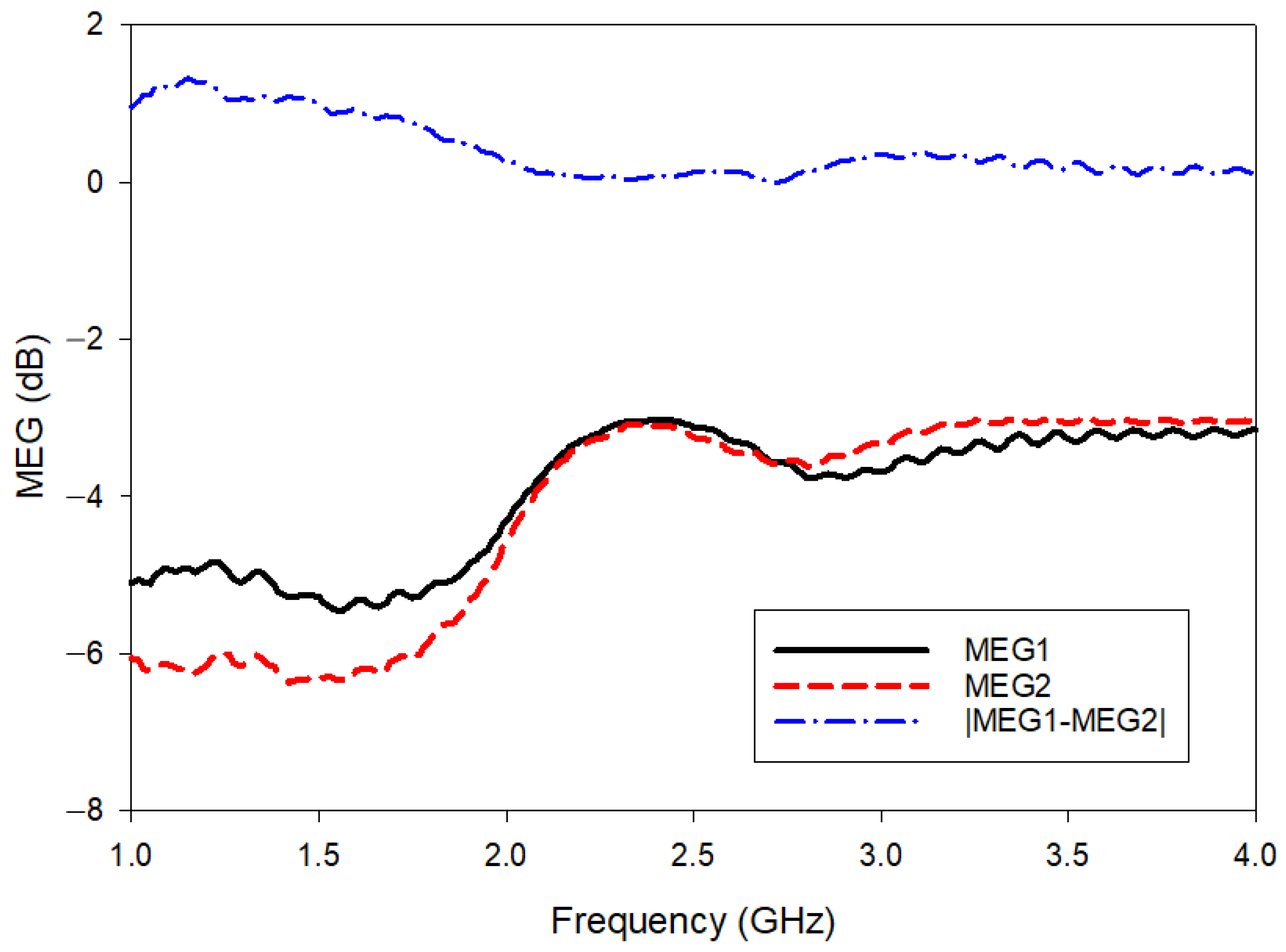
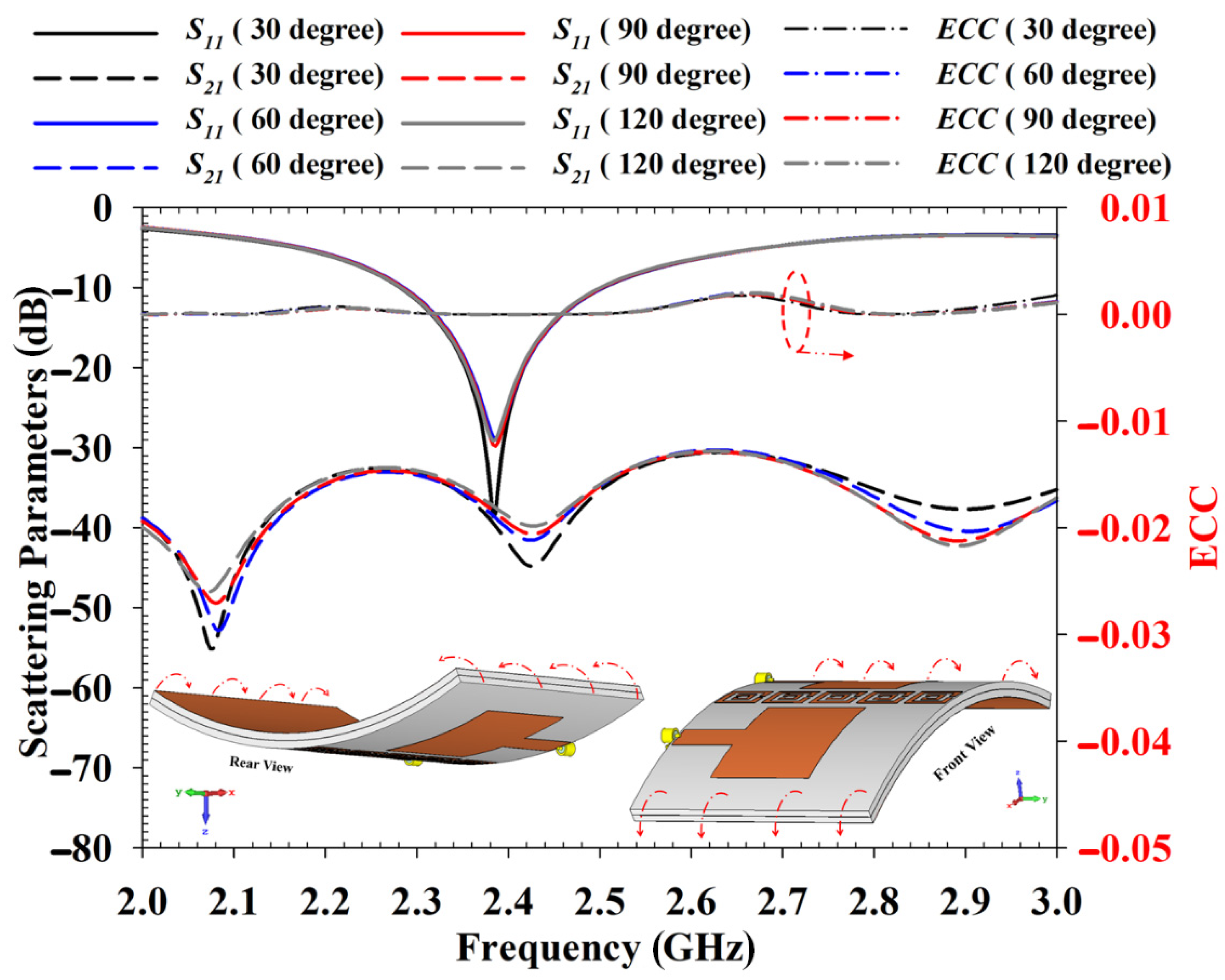
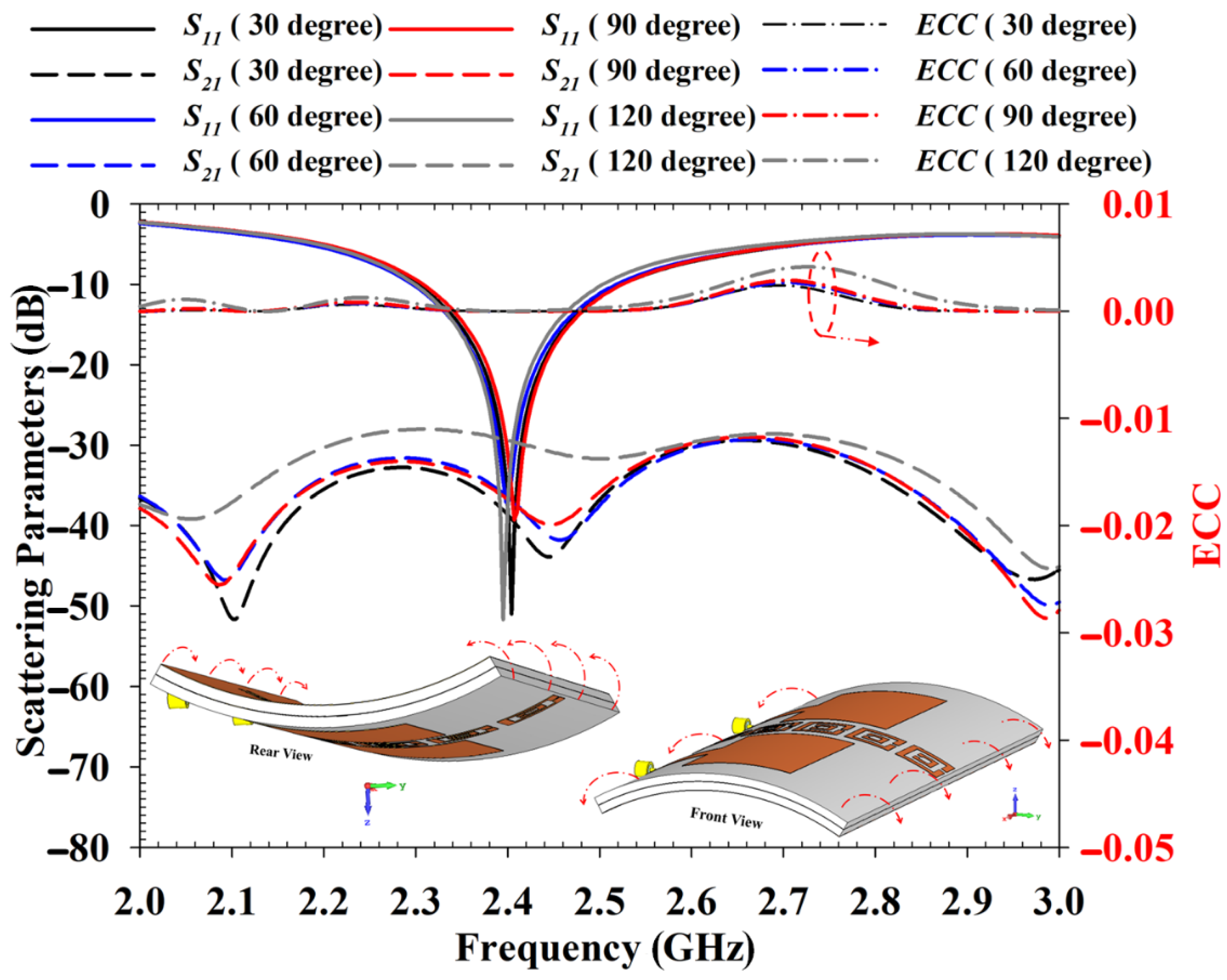
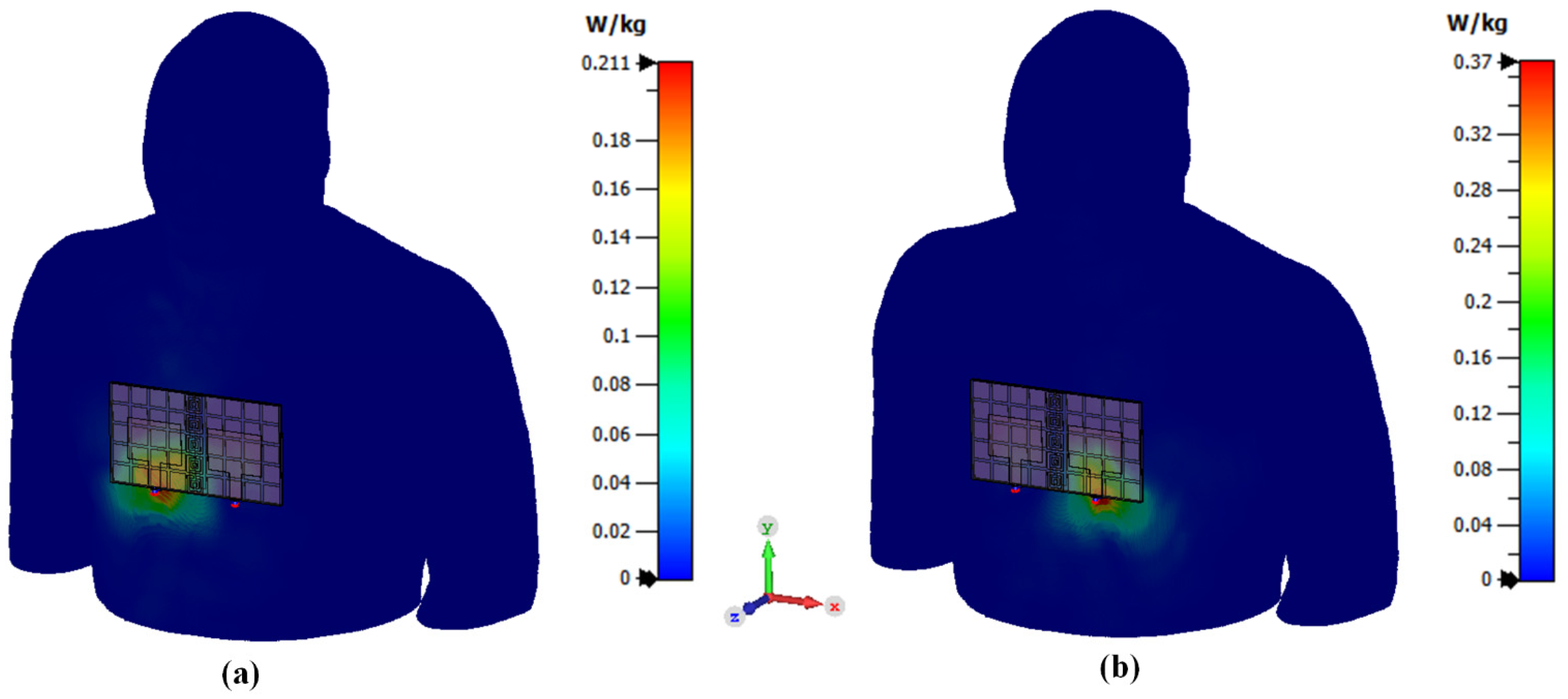
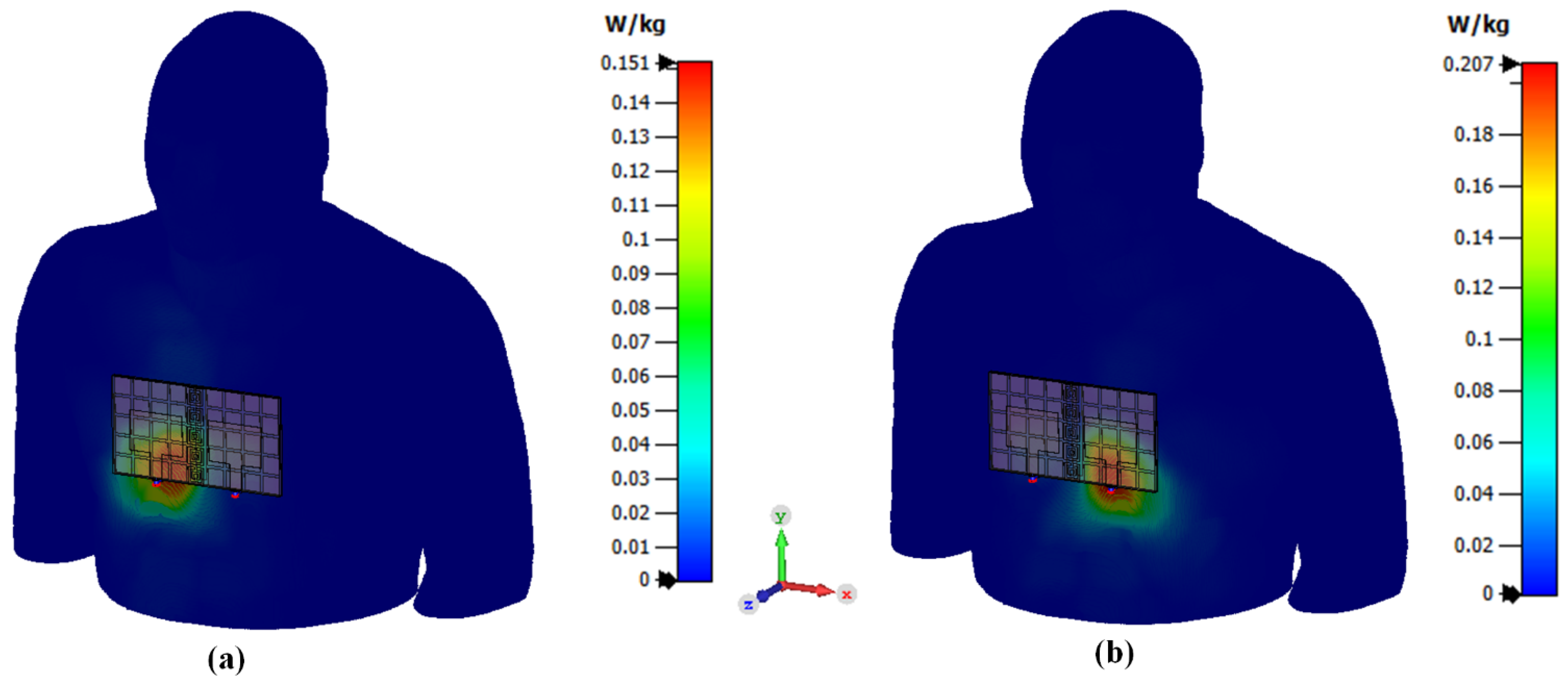
| Para. | Value (mm) | Para. | Value (mm) |
|---|---|---|---|
| Ws | 110.0 | Wf | 13.0 |
| Ls | 106.0 | Lf | 26.8 |
| Wp | 60.0 | Wo | 24.0 |
| Lp | 40.0 | Yo | 5.5 |
| Para. | Value(mm) | Para. | Value(mm) |
|---|---|---|---|
| ae | 21.0 | de | 4.0 |
| ge | 2.0 | se | 5.0 |
| be | 18.0 | he | 6.0 |
| ce | 8.0 |
| Reference | Material Used | Operating Frequency (GHz) | Metamaterial Structure/Technique | Antenna Gain (dBi) | Isolation (dB) | Remarks |
|---|---|---|---|---|---|---|
| [38] | Substrate: Viscose-wool felt Conductive sheet/element: Shieldit SuperTM | 2.4 & 5 | Substrate integrated waveguide (SIW) | NA | 20 | The investigation was conducted on MIMO antenna performance, but no specific method was used to reduce the mutual coupling |
| [39] | Substrate: Jeans Conductive sheet/element: Copper sheet | 2.74–12.0 | 8-shaped stub on a ground plane | 6.9 | 26 | Ultrawideband antenna design with 2 element MIMO Integration of copper sheet with jeans was not shared |
| [40] | Substrate: Jeans Conductive sheet/element: Copper sheet | 3.5–8 | Microstrip neutralization line | NA | 32 | Ultrawideband antenna design with 2 element MIMO Integration of copper sheet with jeans was not shared |
| [19] | Substrate: Standard felt Conductive sheet/element: Cotton fabric | 1.1–8.6 | - | 7.5 | 40 | The use of cotton fabric as the patch in the antenna design is not practical. While no specific mutual coupling reduction technique was used to achieve high isolation. |
| [28] | Substrate: Jeans Conductive sheet/element: Copper sheet | 1.5–3.8 4.2–6.2 | Meanderline | 2–5 | 25–33 | A Dual-band antenna was designed with 4 element MIMO Integration of copper sheet with jeans was not shared |
| This work | Substrate: Viscose-wool felt Conductive sheet/element: Shieldit SuperTM | 2.16–2.66 | RIS EBG | 5.8 | 40 | RIS was used to miniaturize the antenna, increase the antenna gain (+1.29 dBi) and bandwidth. Mutual coupling reduction in MIMO antenna |
Publisher’s Note: MDPI stays neutral with regard to jurisdictional claims in published maps and institutional affiliations. |
© 2022 by the authors. Licensee MDPI, Basel, Switzerland. This article is an open access article distributed under the terms and conditions of the Creative Commons Attribution (CC BY) license (https://creativecommons.org/licenses/by/4.0/).
Share and Cite
Shamsuri Agus, A.N.S.; Sabapathy, T.; Jusoh, M.; Abdelghany, M.A.; Hossain, K.; Padmanathan, S.; Al-Bawri, S.S.; Soh, P.J. Combined RIS and EBG Surfaces Inspired Meta-Wearable Textile MIMO Antenna Using Viscose-Wool Felt. Polymers 2022, 14, 1989. https://doi.org/10.3390/polym14101989
Shamsuri Agus ANS, Sabapathy T, Jusoh M, Abdelghany MA, Hossain K, Padmanathan S, Al-Bawri SS, Soh PJ. Combined RIS and EBG Surfaces Inspired Meta-Wearable Textile MIMO Antenna Using Viscose-Wool Felt. Polymers. 2022; 14(10):1989. https://doi.org/10.3390/polym14101989
Chicago/Turabian StyleShamsuri Agus, Amira Nur Suraya, Thennarasan Sabapathy, Muzammil Jusoh, Mahmoud A. Abdelghany, Kabir Hossain, Surentiran Padmanathan, Samir Salem Al-Bawri, and Ping Jack Soh. 2022. "Combined RIS and EBG Surfaces Inspired Meta-Wearable Textile MIMO Antenna Using Viscose-Wool Felt" Polymers 14, no. 10: 1989. https://doi.org/10.3390/polym14101989
APA StyleShamsuri Agus, A. N. S., Sabapathy, T., Jusoh, M., Abdelghany, M. A., Hossain, K., Padmanathan, S., Al-Bawri, S. S., & Soh, P. J. (2022). Combined RIS and EBG Surfaces Inspired Meta-Wearable Textile MIMO Antenna Using Viscose-Wool Felt. Polymers, 14(10), 1989. https://doi.org/10.3390/polym14101989










